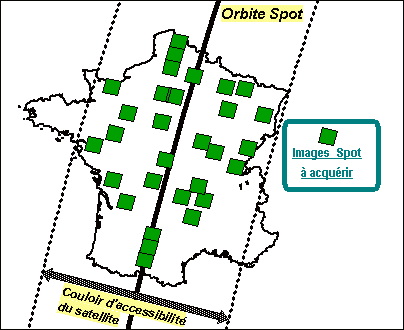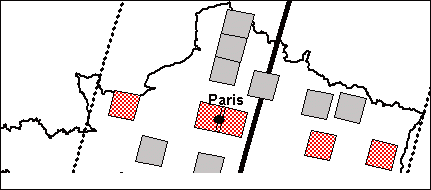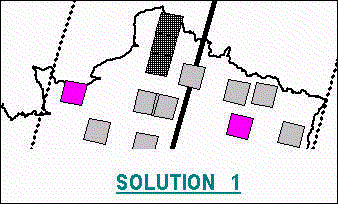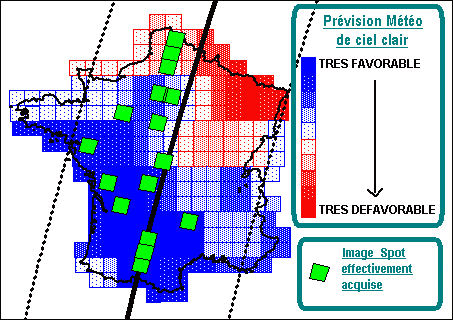In preparation for SPOT 4's operational exploitation, CNES has extensively upgraded
the SPOT acquisition programming system. Acquisition programming covers all tasks
from enquiries concerning programming requests to imagery
acquisition by one or more SPOT satellites.
By making better use of the system's acquisition capabilities, the new programming
centre, commissioned in April 1995, allows Spot Image to offer its customers improved
acquisition programming services, including :
- faster turnaround, or shorter intervals between request approval and
successful acquisition,
- fewer acquisition attempts to obtain satisfactory imagery
(i.e. scenes that are cloud-free, meet all technical specifications, cover the region of
interest, etc.),
- optimal sharing of system resources between all competing requests,
- improved survey progress reporting,
- optimal use of onboard recorders and receiving stations to acquire and
transmit the required scenes.
The programming centre is operated by Spot Image, the CNES subsidiary handling the
distribution and marketing of SPOT data and products.
[Programming requests] [Main functions] [Selecting the best scenes]
[An example of optimal scene selection]
top of page, article

Whenever customers fail to find the imagery they require in the Dali
catalogue of scenes held in the SPOT archive, they can fill out a programming
request giving a detailed description of their imagery needs. Each programming
request gives all the technical details needed to program the satellite, including :
- survey period : survey beginning and end dates spanning a period from one day to
several months,
- survey area (polygon, circle, etc.) : defined by latitude and longitude,
- technical requirements : stereopair for relief mapping, panchromatic
or multispectral spectral mode, repeat acquisitions at specified intervals for
crop or vegetation monitoring, etc.,
- type of programming service :
- red service for priority access to satellite resources, the cost being
proportional to the number of attempts needed to record the required imagery;
- blue service involves an obligation as to the means mobilized to meet
the request to the best extent possible, the cost being proportional to the number of
scenes successfully acquired, irrespective of the number of attempts. This service has,
however, a lower priority than a red service request.
Programming requests are stored in a customer-accessible database.
top of page, article
The new programming centre :
- Manages programming requests and related services offered to Spot Image customers.
- Manages the programming slots allocated to direct receiving stations
around the world. As privileged Spot Image customers, these stations can reserve in
advance certain orbital slots within range of their antennas, program imagery acquisition
within these slots, then receive and process the corresponding scenes.
- Prepares the daily work schedule and a detailed list of all scenes to be
acquired the next day by each SPOT satellite, taking into account, for each
satellite : current status, predicted orbit and image data downlink plan negotiated
with direct receiving stations.
- Assesses each new programming request's chances of successful acquisition
under the conditions specified by the customer and its impact on other requests already in
the pipeline. This will allow Spot Image to fulfill more programming requests and give
customers an indication of the chances of successful acquisition by a given date. By
optimizing the handling of all programming requests, the company will also ensure higher
overall customer satisfaction.
- Automatically validates successfully acquired scenes and reprograms
scenes judged as "unsatisfactory". Each scene is analysed as to cloud
cover and the analysis appended to programming requests in progress otherwise satisfied in
technical terms. Scenes that are declared "satisfactory" can then be forwarded
to the Archive and
Preprocessing Centre for production.
top of page, article
Given the cyclical variations in the number of programming requests,
which tend to focus on certain regions at certain times (typically crops and vegetation
during the spring and summer), the programming centre must select, each day, the
scenes offering the best chance of successful acquisition.
This selection process must also take into account such technical considerations
as :
- time required to make the satellite and imaging instruments ready to acquire a region of
interest,
- operational constraints applicable to certain items of equipment (pre-heating time,
etc.),
- capacity of the onboard recorders,
- need to download image data during passes over the main receiving stations.
top of page, article

Let us consider a typical day's acquisition over France. As can be
seen from the diagram below, the satellite could acquire some 30 scenes on this particular
day.

At the latitude of Paris, five scenes are within the satellite's observable corridor,
but the imaging instruments can only acquire two at a time. It is the programmer's job to
choose which solution is the best.

Using a sophisticated algorithm based on operations research, the programming centre
prepares a daily schedule of all theoretically accessible scenes. This
algorithm takes account of :
- satellite constraints dictated by onboard equipment capabilities
(magnetic recorders, solid-state memory, image telemetry transmitter, etc.),
- programming request constraints, including survey period, commercial
importance of request, high priority for stereo scenes required to complete stereopairs,
etc.),
- plus cloud cover forecasts supplied by Météo-France, Toulouse.
The programming centre's scheduling software can thus analyse, depending on the volume
of input data, several thousand, perhaps even several million, acquisition
sequences and combinations and identify the optimal sequence or combination.
In our example, there are at least four acquisition possibilities as SPOT flies over
the Paris latitude :

Various pairs of acquisition
solutions
Suppose the programmers choose to acquire the three-scene data strip extending across
northern France. This immediately eliminates solutions 2 and 4, since the satellite will
not have the time to move its strip-selection mirrors from the previous positions to the
new ones. Solution 1 remains technically feasible, but the prospects for clear skies are
not good. The programming centre therefore chooses scheduling solution 3
since it combines technical feasibility and the most favourable cloud forecast.

The scheduling algorithm analyses every possible acquisition sequence and path
along each portion of each orbital revolution to identify that representing the
best overall compromise.
top of page, article, section

page updated on the 00-06-06
![]()
![]()




![]()